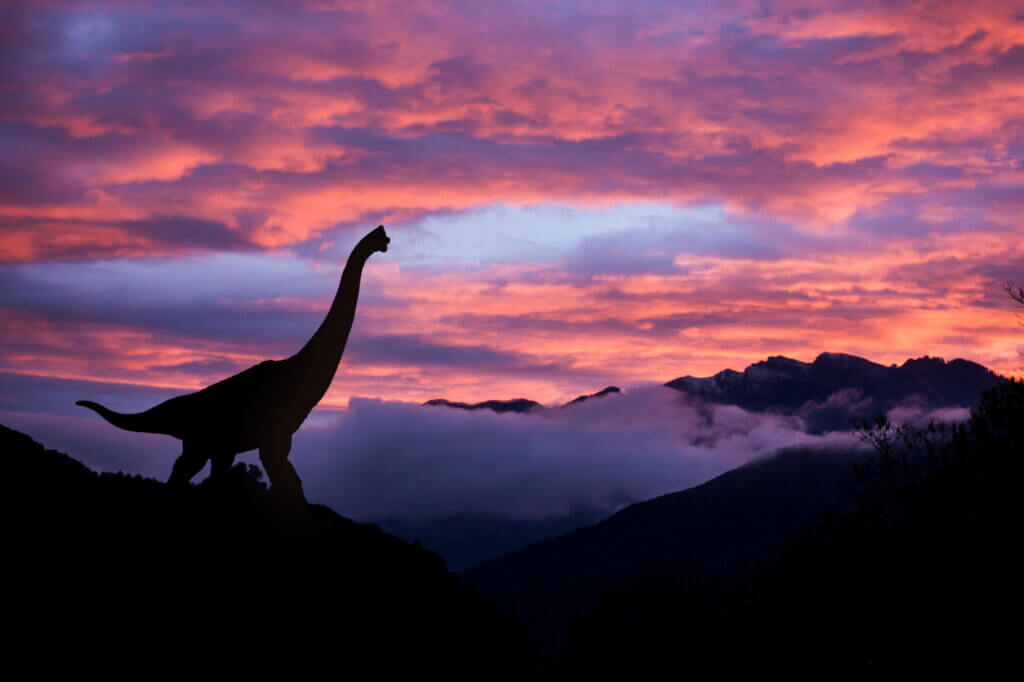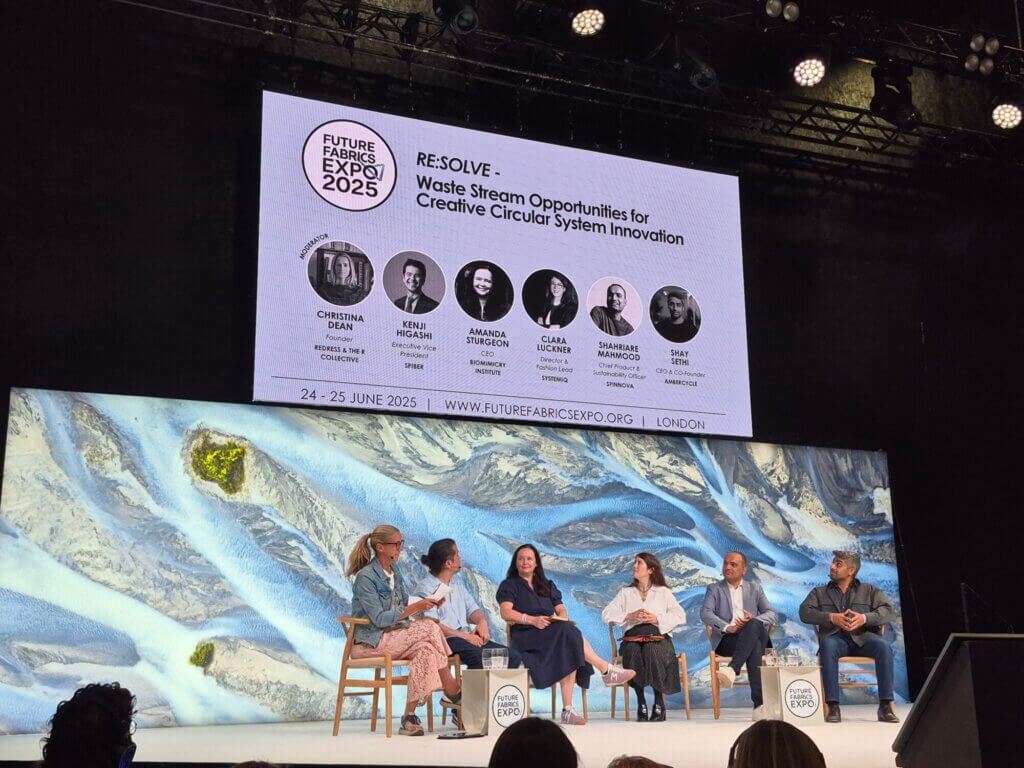
I recently had the incredible opportunity to be a part of Circularity 2025, hosted by Trellis, in beautiful Denver, Colorado with a view of the stunning Rocky Mountains. As a keynote speaker on Day 1, representing the Biomimicry Institute, I am deeply honored to have shared the stage with leading thinkers and practitioners in the circular economy space.
This event was a gathering of minds dedicated to navigating the crucial transition from a linear to a circular and regenerative economy. Over two days of keynotes and events, we journeyed from exploring fundamental schools of thought to delving into tangible actions and real-world solutions. This post shares some key takeaways and reflections from the event.
Day 1: Grounding in Foundational Thought
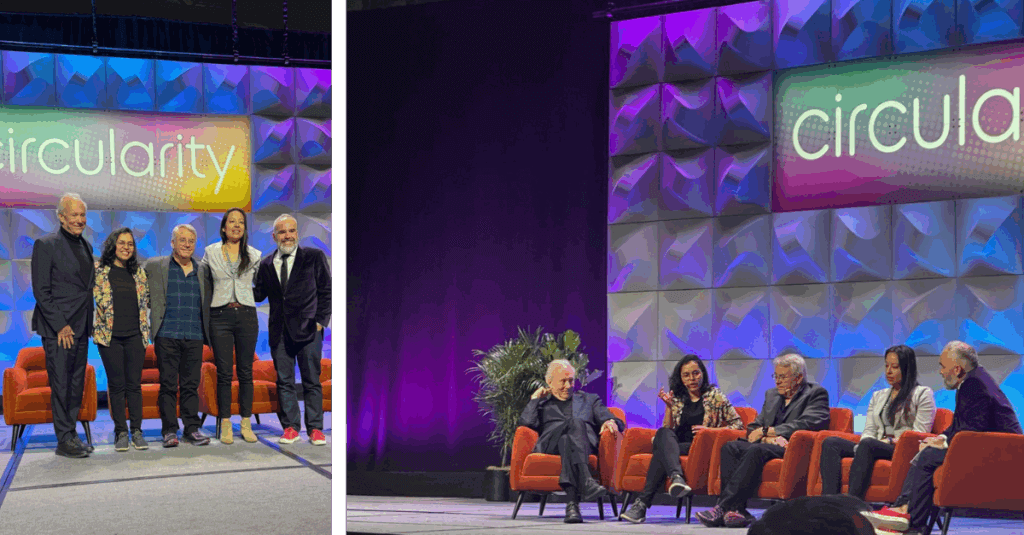
The first day of Circularity 2025 was dedicated to exploring the fundamental schools of thought that help us understand the circular economy today. The goal was to guide our thinking as we plan strategies for transitioning to a circular economy. We heard from experts across diverse disciplines: Indigenous knowledge, green chemistry, biomimicry, and cradle to cradle design.
Dr. Lyla June opened the keynotes with a powerful message grounded in Indigenous knowledge. She emphasized that regenerative circular economies are nothing new. Ancient societies developed incredible technologies for soil management and sustainable food systems. Dr. June highlighted that the driving “software” behind indigenous regenerative design isn’t complex technology, but fundamental values: respect, reverence, reciprocity, responsibility, relationality (kinship), restraint, and regeneration. She reminded us that these simple concepts are some of the “greatest technologies in the universe” if we can tap into them. She offered a powerful perspective, suggesting that “true wealth… it’s mutualism and, and collaboration that creates the wealth of nations”.
Following was Dr. John Warner, a co-founder of green chemistry. He spoke about the abundance of data today, but highlighted the critical need to focus on “the how” – how we will invent the necessary technologies for a circular economy. Dr. Warner argued that perhaps “90% of the technology that we need for a circular economy haven’t been invented yet”, pointing to a “fundamental molecular mechanistic impasse”. He stressed the importance of integrating principles of green chemistry into the required curriculum for chemists and inventors, ensuring they understand how to design molecules that are viable in a circular system from the outset. “No problem can be solved at the same level of awareness that created it. This is a clarion call for diversity and inclusiveness” in molecular sciences. He noted that green chemistry aims for “superior performance, appropriate cost, and oh, by the way, is also sustainable and circular”. Dr. Warner emphasized the importance of “humility” and “patient optimism” on this journey, acknowledging how much we still have to learn.
Then came my turn, where I shared about Biomimicry and the work of the Biomimicry Institute. Beginning with an invitation for the audience to imagine an old-growth forest, a system where “the end of one life becomes the beginning of another. Where everything is transformed and everything contributes. It brought forth the question: What if our human design systems work the same way? Nature, with 3.8 billion years of experience, offers us a design manual for creating systems that are resilient, circular, and life-enhancing. Nature’s principles guide us towards a truly circular economy where materials cycle like nutrients.
Nature embraces change, showing us the value in “release and reorganization”. While getting to a world where all materials are benign and biodegradable like a fallen leaf will take time, transitional technologies are essential stepping stones. Ultimately, nature invites us to participate in the ongoing story of regeneration.
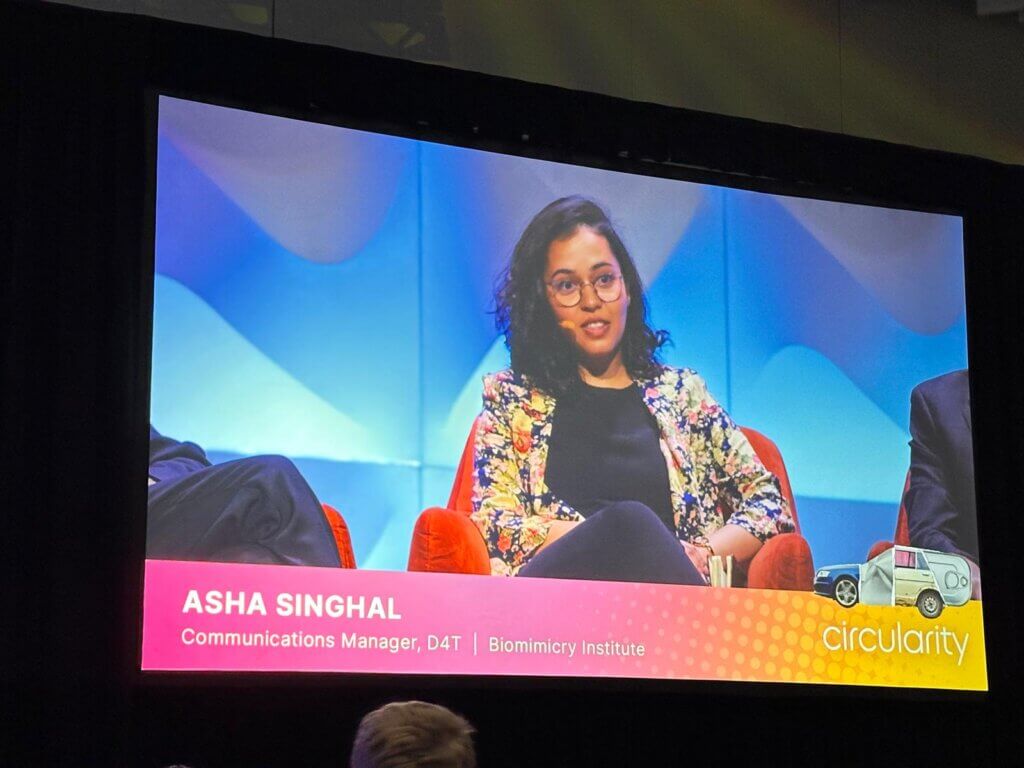
William McDonough concluded Day 1’s keynotes, bringing his seminal work on Cradle to Cradle design to the stage. He framed his approach with the powerful question: How do we love all the children of all species? For all time. His core principles include eliminating the concept of waste entirely, relying on natural energy flows, and viewing nature as a model and mentor. McDonough made a crucial distinction: “being less bad is not being good”. True transformation requires asking “what is the good” rather than just trying to be less wrong. He spoke about designing for the future, creating “perpetual assets” and viewing materials not just as resources, but as relationships. He introduced the idea of the “triple top line” – focusing on revenue, growth, and healthy systems; rather than just the bottom line of profit. “Nature doesn’t have a design problem. People do.”. He emphasized that this movement is about first values and what we believe in.
The Day 1 keynotes set a powerful stage, grounding our thinking in deep, foundational principles and reminding us that the circular economy is rooted in ancient wisdom, scientific innovation, and nature’s enduring intelligence
Day 2: Acting Within the World
Day 2 shifted the focus to “acting within the world”, exploring: what motivates real tangible action. The keynotes highlighted what’s happening across the economy, from startups to tech giants and emerging leaders.A major highlight was the Startups to Watch Competition. This fast-paced pitch event showcased incredible innovation in the circular economy space. Five finalists – MacroCycle Technologies (PET recycling), Renegade Plastics (alternative fabrics), Aruna Revolution (winner, compostable fibers), Re-Fresh Global (textile waste), and EatCloud (food distribution) – demonstrated how circular economy entrepreneurs are “reinventing entire industries”. Investors like Aly Bryan (Closed Loop Partners) and Ginger Rothrock (HG Ventures) offered valuable feedback, highlighting the viability of these new business models. Aly Bryan noted that this is a “unique time to be thinking about building businesses that function with capitalism, for growth instead of capital as a precondition for survival”.
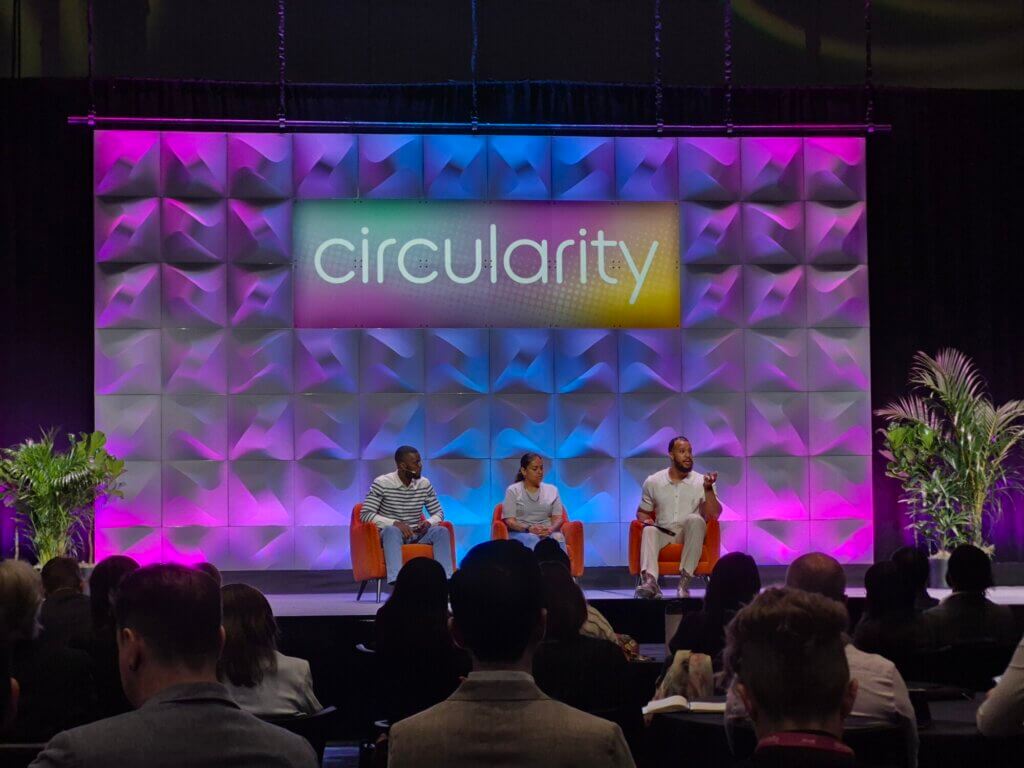
The Emerging Leaders program was also prominently featured, highlighting the next generation of sustainability professionals of color. This program focuses on fostering not just inclusion, but belonging. We heard incredibly moving and inspiring stories, particularly from John Williams of WasteWell/Bennett Compost and Jeannette Felix from Homeboy Industries. They shared how re-entering the workforce through circular economy jobs provided training, support, and a sense of community. Jeanette Felix emphasized that “overall you have to sort of look out for your community. Your community is a big part of what is gonna build you and build everybody”. Brian Lewis stressed the importance of businesses and individuals to come together and support the next generation. John Williams shared his experience hiring formerly incarcerated individuals, noting that someone gave him a chance, and they just need that opportunity.
Other speakers and interviews throughout the day provided specific examples of action:
- Joe McLeod and Andy Rubin spoke about the need for brands to tell the full story of a product’s lifecycle, not just the initial sale -what would it look like if the products that brands sold took us through the entire story?
- Rey Banatao from X (Google’s Moonshot Factory) discussed their project to reimagine a “world without waste” at the molecular level. He talked aboutI circularity as a “systems problem” and stressed that solving it requires diverse expertise; we need policy makers, educators, business people and lawyers in addition to scientists and technologists to address this problem. He stated that the principle is to “fall in love with the problem”.
- Eradajere Oleita, an Emerging Leader and founder of the Chip Bag project, shared how she collects Mylar waste globally and transforms it into useful items like sleeping bags and tote bags. Her simple, powerful advice: “Circular opportunities are right under our nose. We should be looking at everything” and “Question everything”. She also called for experienced leaders to Invest more dollars, time, everything in young people and circular initiatives.
- Julia Marsh from Sway showcased seaweed-based biomaterials and packaging, emphasizing the connection to ocean health and healthy soil. She advocated for giving Compostables a chance. Her perspective is that the end of life can become return to life where materials replenish soil health.
- Yuli Fuentes of the Footwear Collective discussed bringing competitors together in the footwear industry to work on circularity, viewing the shoe as a model for other products. She highlighted the power of collaboration, creating a community of humans who have the superpowers to change an industry. She added that “no is a relative” concept and we should “push the limits”.
These examples vividly demonstrated the transition from theoretical understanding to practical, impactful work happening on the ground.
Overarching Themes and Insights
Several powerful themes resonated throughout both days, weaving together the different perspectives and actions:
- Action and Progress:
There was a clear call to move beyond just observing the world to acting within it. The idea of “progress over perfection” was discussed, emphasizing the importance of doing something rather than waiting for the perfect solution. As Deanna Bratter put it, the transformation requires being “super pragmatic”. Every step counts, and we should “feel really good about” taking those steps. - Collaboration and Community:
The need for deep collaboration across industries, disciplines, and communities was a constant refrain. “This cross-collaboration is the way to both environmental and economic success, not silos”. Yuli Fuentes Medel highlighted the power of building a collaborative community even among competitors. The Emerging Leaders program showed the vital role of community and mutual support. As Bill McDonough noted, we need to become “multi disciplinarians… share with each other… learn from each other”. - Innovation and Reinvention:
Circularity is fundamentally about innovation – not just in technology, but in design, business models, and social systems. Entrepreneurs are “reinventing entire industries”. Dr. Warner highlighted the need to invent 90% of the needed technologies, while Rey Banatao stressed reimagining systems at the molecular level. - Storytelling:
The importance of telling the “full story” of circularity, both for brands and for the individuals involved, was emphasized. - Values and Humility:
The movement is rooted in shared values, not just economic value. It’s about “first values” and recognizing our interdependence. Humility is essential, acknowledging that we don’t have all the answers. As Dr. Warner said, “put the ego aside and… learn from nature, from Indigenous culture”. - Specificity and Focus:
Moving forward requires getting “specific, tactical, detailed and focused on solving real business and planet relevant problems”.
The event showcased a wide range from micro to macro, connecting ancient practices to modern problems and exploring solutions from the molecular level to global supply chains.
Personal Reflection & The Biomimicry Lens
Being on the keynote stage for Circularity 2025, speaking to such an engaged and thoughtful audience, was both humbling and inspiring. Sharing the principles of Biomimicry, learning from nature’s elegant and cyclical systems, felt incredibly relevant and timely. Nature’s model, where everything is transformed and everything contributes, provides a powerful blueprint for the circular economy we are striving to build. The discussions throughout the event reinforced how deeply intertwined nature’s principles are with the economic, social, and technological innovations needed for a regenerative future.
Seeing the diverse approaches, from Indigenous wisdom and green chemistry to innovative startups and community-focused initiatives, through the lens of biomimicry highlighted the shared goal: creating systems that function harmoniously, much like natural ecosystems. The emphasis on collaboration, adaptation, and regeneration echoed nature’s own strategies for resilience and evolution.What stuck with me most was the immense breadth of the movement, covering everything from the smallest molecules to global systems. Jon Smieja’s mention of the concept of Umwelt – how different organisms perceive the world differently – resonated deeply with the need for diverse perspectives and breaking down biases in the circular economy space. There lies a connection between ancient practices and modern problems, reinforcing that we are addressing a timeless challenge. There was a clear sense of momentum and a collective commitment to action, fueled by innovation and a shared purpose.
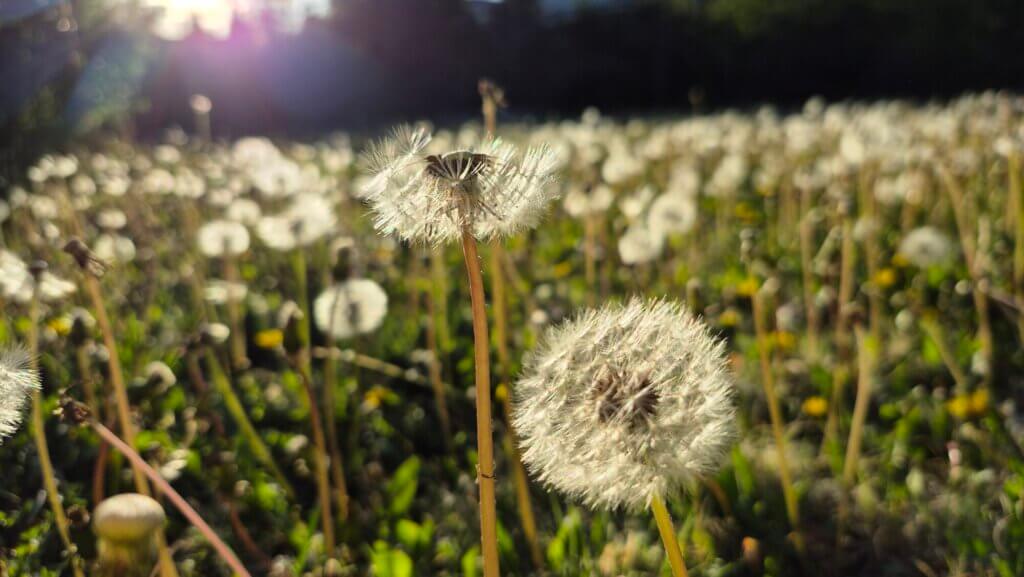
Final Thoughts:
Circularity 2025 was filled with energy, insights, connections and collaborations. It underscored that the transition to a circular economy isn’t just necessary; it’s underway, driven by bold vision, deep collaboration, and a focus on tangible results.
As Rey Banatao urged, “fall in love with the problem”. As Ada Oleta advised, “Question everything” and look for “Circular opportunities… right under our nose”. We need to “change the way [we] see”. We need to think about our community and how we can contribute. Embrace the intelligence of natural systems and learn from nature’s timeless principles.
The momentum is building, and events like Circularity 2025 provide the crucial platform for connection, learning, and catalyzing further action. I’m already looking forward to future gatherings, such as Trellis Impact 26.
Let’s choose to be the ancestors who not only imagined but actively built a regenerative, nature-positive future.
Asha Singhal is the Nature of Fashion Communications Manager, a biomimicry practitioner, architect, designer, and researcher dedicated to crafting regenerative environments. Through her work, Asha focuses on narrative change as a powerful tool to shift cultural paradigms, moving beyond isolated solutions to address systemic challenges. Integrating biology, architecture, art and technology, she weaves pragmatic narratives of hope inspired by nature. She has been involved in several initiatives to bridge nature-positive futures with reality such as The Ray Highway, Perennial Tx and Born Global Foundation to name a few.
Asha is the Co-Director & Co-Founder of the Futuring Collective, an initiative that helps teams imagine and communicate hopeful futures. She has served as the Executive Design Lead at Biomimicry Frontiers and Research Advisor of Sustainability at Biomimicry Academy. With an international portfolio spanning diverse projects, she advocates for a world where our systems not only harmonize with nature but also shape a possible and regenerative tomorrow.
Learn more about Asha and the rest of the Biomimicry Institute team here.


